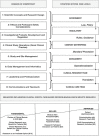Reimagining the joint task force core competency framework for rural and frontier clinical research professionals conducting hybrid and decentralized trials
- PMID: 38178857
- PMCID: PMC10764479
- DOI: 10.3389/fphar.2023.1309073
Reimagining the joint task force core competency framework for rural and frontier clinical research professionals conducting hybrid and decentralized trials
Abstract
Introduction: Clinical research professionals (i.e., clinical research assistants, clinical research nurses, clinical research coordinators, etc.), as outlined by the Joint Task Force (JTF) Core Competency Framework, are highly trained to support the breadth of clinical trial operations and manage participant care. Clinical research professionals are uniquely equipped with a scope of practice that permits product administration, participant assessments, and data management. As clinical trials grow in complexity and their management expands beyond traditional, site-based operations models to decentralized and/or hybrid models, the need becomes great to ensure adequate staffing. However, rural hospitals frequently lack the research staff or patient recruiters that would allow them to support decentralized clinical trials across a sizeable rural geographic demographic. Methods: This paper examines the contributory factors of the clinical research professional workforce contraction and response efforts at professional and organizational levels within a large, Magnet-designated healthcare system in the rural northwestern United States. Perspectives are shared on adapting the Core Competency Framework to reflect the unique strengths and opportunities towards decentralized trials in rural regions of the United States and areas of priority for workforce cultivation and retention. A descriptive survey was used to gather initial data identifying the current research perspectives of healthcare workers working across a rural community. Participants were asked to complete questions about the JTF Competency domains and behavior-based questions. Analysis: Both competency and behavior-based questions were asked and related to roles. These were then cross-referenced using a Rasmussen Ladder system. Descriptive statistics were conducted for sample characteristics, self-reported competency domain questions, and behavior questions. Results and discussion: Survey findings suggest that although healthcare workers and clinical research teams interact, they are unlikely to ask their patients to participate in research. Based on the limited response rate, results suggest that better education throughout the rural community could benefit from decentralized research efforts. Increased use of technology was also highlighted as an area of interest.
Keywords: clinical research professional; clinical research workforce; clinical trial enrollment; decentralized trials; frontier; joint task force competency framework; rural.
Copyright © 2023 Besel, Johnson, Ma and Kiesow.
Conflict of interest statement
The authors declare that the research was conducted in the absence of any commercial or financial relationships that could be construed as a potential conflict of interest.
Figures
Similar articles
-
Trouble for trials - The worrying state of the research nurse workforce.Contemp Clin Trials. 2022 Sep;120:106878. doi: 10.1016/j.cct.2022.106878. Epub 2022 Aug 12. Contemp Clin Trials. 2022. PMID: 35964869
-
The Experience and Effectiveness of Nurse Practitioners in Orthopaedic Settings: A Comprehensive Systematic Review.JBI Libr Syst Rev. 2012;10(42 Suppl):1-22. doi: 10.11124/jbisrir-2012-249. JBI Libr Syst Rev. 2012. PMID: 27820153
-
Building a sustainable rural physician workforce.Med J Aust. 2021 Jul;215 Suppl 1:S5-S33. doi: 10.5694/mja2.51122. Med J Aust. 2021. PMID: 34218436
-
Joint Task Force for Clinical Trial Competency and Clinical Research Professional Workforce Development.Front Pharmacol. 2018 Oct 16;9:1148. doi: 10.3389/fphar.2018.01148. eCollection 2018. Front Pharmacol. 2018. PMID: 30386238 Free PMC article. Review.
-
Recruitment and retention of healthcare professionals in rural Canada: A systematic review.Can J Rural Med. 2020 Apr-Jun;25(2):67-78. doi: 10.4103/CJRM.CJRM_43_19. Can J Rural Med. 2020. PMID: 32235108
Cited by
-
Research on Core Competency Elements of Clinical Investigators.Ther Innov Regul Sci. 2025 Jan;59(1):45-53. doi: 10.1007/s43441-024-00688-5. Epub 2024 Nov 29. Ther Innov Regul Sci. 2025. PMID: 39612157
-
Assessment of competencies of clinical research professionals and proposals to improve clinical research in Portugal.Front Pharmacol. 2025 Apr 8;16:1578955. doi: 10.3389/fphar.2025.1578955. eCollection 2025. Front Pharmacol. 2025. PMID: 40264669 Free PMC article.
-
Construction of a competency evaluation model for Clinical Research Coordinators in China: a study based on the Delphi method and questionnaire survey.BMJ Open. 2024 Sep 17;14(9):e083957. doi: 10.1136/bmjopen-2024-083957. BMJ Open. 2024. PMID: 39289011 Free PMC article.
References
LinkOut - more resources
Full Text Sources
Research Materials




